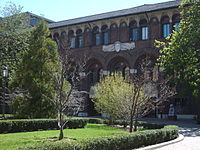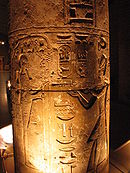

The University of Pennsylvania Museum of Archaeology and Anthropology — commonly called Penn Museum — is an archaeology andanthropology museum that is part of theUniversity of Pennsylvania in theUniversity City neighborhood ofPhiladelphia, Pennsylvania.
History
An internationally renowned educational and research institution dedicated to the understanding of cultural diversity and the exploration of the history of humankind, the University of Pennsylvania Museum of Archaeology and Anthropology—which has conducted more than 400 archaeological and anthropological expeditions around the world—was founded during the administration of Provost William Pepper. In 1887, Provost Pepper persuaded the Trustees of the University of Pennsylvania to erect a fireproof building to house artifacts from an upcoming expedition to the ancient site of Nippur in modern-day Iraq (then part of the Ottoman Empire). During the late 19th and early 20th centuries, North American and European museums regularly sponsored such excavations throughout the Mediterranean and Near East, sharing the ownership of their discoveries with the host country. Penn Museum followed this practice in acquiring the vast majority of its collections, and, as a result, most of the Museum's objects have a known archaeological context, increasing their value for archaeological and anthropological research and presentation. Today the Museum's three floors of gallery space feature materials from the ancient Mediterranean World, Egypt, the Levant, Mesopotamia, South and East Asia, and Mesoamerica, as well as artifacts from the native peoples of the Americas, Africa, and Oceania. Since 1958, the Penn Museum has published Expedition Magazine. (ISSN 0014-4738) The excavations and collections of the Museum provide resources for student research and the Museum hosts the Graduate Group in the Art and Archaeology of the Mediterranean World.
2009 Restructuring
On 19 November 2008, University of Pennsylvania Museum Administration announced its decision to terminate 18 Research Specialist positions in archaeological and anthropological research in the Mediterranean world, the Middle East, and the Americas, effective May 31, 2009. The scientific research center MASCA (Museum Applied Science Center for Archaeology)] was also closed, although the MASCA scientists were moved to other Sections within the museum. The decision receivedlocal and world-wide criticisms and reactions among archaeologists and concerned communities, who felt that it represented a decided departure from the original mission of the Penn Museum as a research institution since its foundation in 1887. Museum administrators announced that this was a measure taken due to the current financial crisis and the deep budget cuts at the University of Pennsylvania.
On June 1, then-Director Dr. Richard Hodges announced that newly defined positions as "Associate Curator" or "Research Project Manager" have been offered to 11 of the 18 individuals affected.
The Museum has stated that its commitment to research remains firm, as indicated by more than 50 research projects spanning five continents that engage nearly 200 Museum-affiliated scholars—more than can be found at any other archaeological and anthropological institute/museum in North America.
Museum building

The Stoner Courtyard at the Penn Museum
The Museum is housed in an Arts and Crafts andEclectic style building that is one of the landmarks of the University of Pennsylvania campus. The existing original building (onto which have been grafted several later additions) is actually only approximately one-third of an ambitious design that would have created one of the largest museum buildings in the United States. Features of the extant building include a dramatic rotunda and gardens that include Egyptian papyrus. The Penn Museum was designed by a team of Philadelphia architects, all of whom taught on the faculty of the University: Wilson Eyre, Cope & Stewardson and Frank Miles Day. The first phase was completed in 1899 and housed the discoveries from an expedition sponsored by the University to the ancient site of Nippur. In 1915, the rotunda, which houses the Harrison Auditorium in the basement was completed. Charles Klauder designed the Coxe Memorial Wing, which opened in 1926 to house the Museum's Egyptian collection. The Sharpe Wing was completed in 1929.
The Coxe Memorial Egyptian Wing was added to the museum in 1924 through a bequest by former museum board president Eckley Coxe. The administrative wing was added in 1929. The Academic Wing, which provided laboratories for the Anthropology department and classrooms was opened in 1971. The most recent major addition was made in 2002, with the addition of the Mainwaring (Collections Storage) Wing.
Collections
Penn Museum's extensive collections fall into two main divisions: archaeology, the artifacts recovered from the past by excavation, and ethnology, the objects and ideas collected from living peoples. There is also an extensive collection of skeletal material, which is not on display. More than 30 galleries feature materials from around the world and throughout the ages including:
China
The Chinese collection is housed in a spacious gallery underneath the museum's Harrison Rotunda, which measures ninety feet across and ninety feet from the floor and is one of the largest unsupported masonry domes in the nation. This gallery houses large paintings and sculptures, as well as a perfectly spherical carved Chinese crystal which belonged to Empress Dowager Cixi — one of the finest in existence. Along with an Egyptian status of Osiris, the crystal ball was stolen in 1988, and its elegant silver stand, a stylized ocean wave, was found in a culvert not far from the Museum. The items were recovered in 1991 after a former museum staff member saw the statue in an area antique shop; the crystal ball was traced to a home in New Jersey and returned to the Museum.
Egypt

Merneptah presents an offering to Ptah on a stone column (University of Pennsylvania Museum)
The museum's collection of Egyptian artifacts is considered one of the finest in the world. The museum's Egyptian galleries house an extensive collection of statuary, mummies, and reliefs. Most notably, the museum houses a set of architectural elements, including large columns and a 13-ton granite Sphinx of Ramesses II, circa 1200 B.C., from the palace of the Pharaoh Merenptah. These were excavated by a museum expedition to Egypt in 1915. In the late 1970s Karl-Theodor Zauzich (attendant of the Egytian section) discovered 3 missing fragments of theInsinger Papyrus in the Museum's collections.
Iraq
The museum's most important collection is arguably that of the Royal Tombs of Ur, which The University of Pennsylvania co–excavated with the British Museum in Iraq. Ur was an important and wealthy city-state in ancient Sumer, and the artifacts from its royal tombs showcase the city's wealth. The collections consists of a variety of crowns, figures, and musical instruments, many of which have been inlaid with gold and precious stones. The often traveling collection includes a well known Bull-headedlyre. The museum's Babylonian section houses a collection of almost 30,000 clay tablets inscribed in Sumerian and Akkadian cuneiform, making it one of the ten largest collections in the world. The collection contains the largest number of Sumerian school tablets and literary compositions of any of the world's museums, as well as important administrative archives ranging from 2900 to 500 BCE.
Mesoamerica
The Penn Museum conducted an excavation of the Mayan city of Tikal, Guatemala from 1956 to 1970. Many important artifacts from this excavation are on view in the museum, along with several stelae from the contemporary cities of Caracol andPiedras Negras. The gallery also displays many Aztecan, Oaxacan, and Teotihuacano artifacts.



















